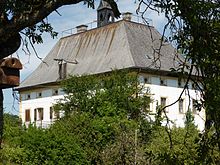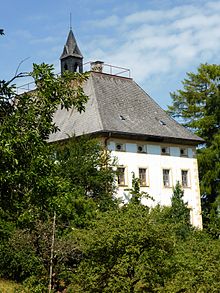Seehaus Castle
The lock Seehaus is located in the town district lake house the community Petting in the district of Upper Bavaria at the south end of the Weidsees (Seehaus 1).
history
Seehaus was originally a castle owned by the Counts of Thann. Around 1280 the rule was transferred to Archbishop Rudolf of the Archdiocese of Salzburg . For the Archbishopric of Salzburg, the castle was of great importance as a guard post on the medieval Untere Salzstrasse , which went via Waging and Altenmarkt am Inn to Wasserburg am Inn and on to Munich . From Seehaus, the transit of the Reichenhaller and Berchtesgadener salt could be well monitored and charged with tolls, which were of great importance for the ore monastery.
The provost Christoph Ebran Wildberg was 1483/84 on the ring Hamer lake a construction list, " the mer ainem taber because ainem gemainen house is like ." Presumably he was pursuing a personal purpose with the fortress-like building, as he was an opponent of Johann Beckenschlager and had to prepare for a military conflict with him. At that time the building was almost completely enclosed by water.
In 1479 the cost office and patronage court was moved from Petting to Seehaus (the latter was repealed in 1804). In 1519 the bailiff Andre Krumpeckher (until 1529) added “from the lake house”. In 1522 the Salzburg cathedral chapter succeeded in taking over the entire Pettinger property, but it did not come to the formation of a closed Hofmark . From 1530–1535, Balthasar Krumpeckher is administrator at Seehaus, followed by Hans Friesinger (1535–1542). In 1542 Michael Gassenberger (until 1552) was given the two offices of Petting and Saaldorf to manage the Seehaus. Under him the planned expansion of the pond management began. After the Gassenberger's death, his widow stayed in Seehaus to close the official accounts. Caspar Sigenhaimer (1553–1566) became the new administrator. Due to complaints (Sigenhaimer is said to have put aside food and drinks that were intended for the canons), he was dismissed and the next manager was Hans Stöghofer (1566–1571). There were difficulties with this too, so he was not prepared to work on the grape harvest in the estate of the cathedral chapter in Lower Austria . The next manager, Hans Gerber (1571–1576), therefore had to expressly agree to make himself available for such work. Other administrators were Michael Strasser (1576–1578), Wolfgang Kheimb (1578–1582), who was slain by two salt workers, and Bernhard Angerer (1582–1616).
In 1600 the then ruling Archbishop Wolf Dietrich von Raitenau renewed the main building and transferred Seehaus Castle to his partner Salome Alt . Wolf Dietrich had bought their properties in the Seehaus area from Baron Eustachius von Törring and Baron Dietrich Khuen von Belasy and handed them over to Salome Alt. After Wolf Dietrich's forced abdication, the Salzburg Cathedral Chapter had all of Salome Alt's property transferred to it in 1614 and recorded in 1657 newly created landlords . Archbishop Paris Lodron gave in 1653 after the death of Alfons Freiherr von Lamberg the lake house located at Lamberg goods the cathedral chapter, the one Lodron'schen in return Primo and Sekundogenitur agreed. After the amalgamation of all offices, approx. 600 properties were under the Seehaus administration.
Georg Wisenegger (1616–1643), Dominicus Driver (1643–1679), who had repairs carried out on the castle, and finally Franz Hueber (1679–1716) followed in the series of administrators in the offices of Petting, Saaldorf and Seehaus. Under the administration of the Huebers, Seehaus Castle was rebuilt to its present form. In 1703 Franz Hueber donated the Trinity Chapel on Waginger Strasse. He was succeeded by his son, price god Joseph Hueber (1716–1736), who had to retire after bankruptcy. The next manager is Georg Joseph Knoll (1736–1741), who was dismissed without notice because of his lifestyle (alcoholism). Simon Rinnenpichler (1741–1748) was the next to take over official duties. Then followed again from the Hueber family Joseph Kajetan Hueber (1748–1776). In his time, the Seehauser Zehentstadel fell on fire, but the adjacent castle was spared. The next administrator was Joseph Matthäus Ainkäs (1776–1782), who then rose to the position of clerk in Mauterndorf . The next administrators were Franz Seefeldner (1783–1789), Christian Gandolf Paurnfeind (1789–1791, 1804–1806) and Johann Michael Schipfl (1791–1804).
As a result of secularization , the Seehaus manor complex fell to Austria (1805 / 06-1809), then under French administration (1809/10) and finally under Bavarian rule (1810-1816). After the Congress of Vienna , the Saalach and Salzach became part of the western border of Bavaria and the former Salzburg nursing courts Teisendorf, Waging, Tittmoning and Laufen were finally separated from Salzburg. Under Bavarian rule, the individual parts (economy, office building, fisherman's house, tithe and fishing rights) were auctioned by Seehaus. Dismas Paurnfeind, the brother of the last manager, bought the royal domain Seehaus together with the associated robot lines at auction in 1813. As early as 1815 he sold parts of the property to Johann Stubenberger (Amtmannhaus with oven) and to Markus Zenz and Theresia Pastötter (Dammfischerhaus). In 1832 the district court doctor Xaver Jehlin bought the castle with the remaining reasons and tithes. On September 4, 1837, the property went to Countess Josephine La Rosée , who had entered into a community of property with her husband Franz Xaver Berger. The latter had to sell more and more shares in Seehaus. Theodor Berger took over the castle in 1867, his wife Louisa Berger in 1879 and her daughter Elise Berger in 1926. The castle has been owned by the Merkenschlager community of heirs since 1956.
Building history of Seehaus Castle
The oldest part of the castle is the three-storey rear floor (10.3 × 11.4 m), which probably corresponds to the taber built in 1483/84 . Under this is a deeply dug cellar. Seehaus probably changed into a castle in the course of the 16th century, as there was not enough space in the old building for the canons and their servants. The original entrance was in the east, whereby the wall between the later built vestibule and the drinking room was the former outer wall. In 1680 the new Stöckl was built here according to plans by Lorenz Stumpfegger (1641–1709) . This gave Seehaus an L-shaped floor plan and the entrance had to be moved to the south. Originally the castle had a moat roof . In 1780 the chapel tower and the roof structure had to be rebuilt. The ground floor used to be used for official business (archive, chancellery, office) but there was also a drinking room (with kitchen and dining room) for party traffic. The living rooms (including a prince's room ) and an old smoking room are located on the first floor .
Seehaus Castle with a late Gothic house chapel and adjacent sacristy on the ground floor is located directly on the Weidsee, surrounded by a wide belt of reeds, in the middle of the Weidsee nature reserve. The chapel is dedicated to St. Dedicated to Rupertus . The choir is oriented to the west and protrudes with its three-eighth end over the outer wall. In 1985 remains of late Gothic painting were discovered during restoration work . The chapel, which was previously used as a milk vault, was restored in 1679; In 1748 it was equipped with everything that was necessary for a mass celebration.
Now the castle is privately owned by Mrs. Barbara Merkenschlager and her sister Hanna Rossberger and is therefore not open to the public.
literature
- Helga Reindel-Schedl: Running on the Salzach. The old Salzburg nursing courts Laufen, Staufeneck, Teisendorf, Tittmoning and Waging. (= Historical Atlas of Bavaria, part of Altbayern issue 55). Commission for Bavarian History, Verlag Michael Lassleben, Munich 1989, ISBN 3-7696-9940-8 .
- Rosemarie Knapp: Seehaus Castle. The administration of the goods of the Salzburg cathedral chapter in the Rupertiwinkel. Self-published, Laufen 2005.
Individual evidence
- ↑ Helga Reindel-Schedl, 1989, Seehaus Castle , pp. 489–491.
- ↑ In 1856 he was a doctor in Neuötting, cf. Johannes Gistel : Latest geography and statistics of the Kingdom of Bavaria Straubing 1856, p. 312
Web links
Coordinates: 47 ° 53 ′ 58.5 ″ N , 12 ° 49 ′ 14.6 ″ E





